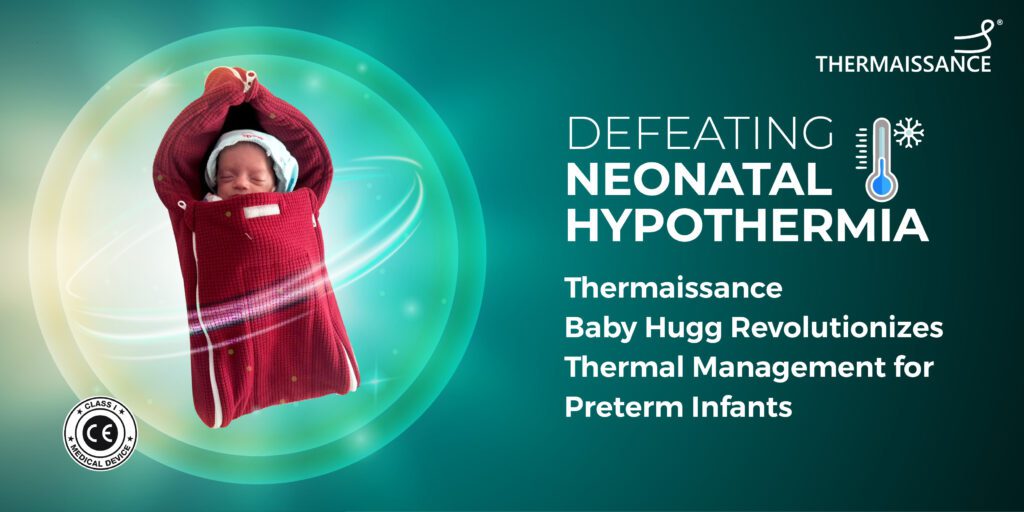
For every new mother, the first few moments after birth are equally precious and worrisome. The instinct to keep one’s baby as close as possible is not just maternal love; it’s a lifesaver for the little one. And for preterm or low birth weight infant care, that warmth can decide whether a baby thrives or struggles.
Preterm infants are especially vulnerable to heat loss from the moment they’re born. Their skin is thin and underdeveloped, allowing rapid evaporation and loss of body heat, especially in the first hour after birth. Because they have a large surface area compared to body weight, limited insulating fat, and immature temperature control mechanisms, they can’t retain or generate enough warmth on their own. Without external thermal support, maintaining a stable body temperature becomes a serious challenge, putting these fragile infants at high risk of neonatal hypothermia.1
Neonatal hypothermia is one of the most persistent threats to newborn survival. It happens when the body temperature becomes extremely low and drops below 36.5°C.2
The increasing risks of hypothermia in newborns are one of the leading causes of higher rates of infection, respiratory distress, and even mortality.3 To address this, the World Health Organization (WHO) developed the “warm chain”, a set of 10 essential steps in essential newborn care (ENC) that promote thermoregulation. These include a warm delivery room, immediate drying, skin-to-skin contact, early breastfeeding, postponed bathing, temperature management in premature babies through appropriate clothing and bedding, warm transportation, and warm resuscitation.2
Yet despite these measures, neonatal hypothermia continues to be common, even in well-equipped hospitals. Studies show that 35–85% of preterm infants suffer from hypothermia (<36.5°C) upon NICU admission.4
Yet, despite these measures, maintaining a stable thermal environment for neonates remains a global challenge.
Where the Risk Is Highest
Even with the best hospital protocols, maintaining neonatal warmth is particularly challenging in:
Premature and low birth weight infants
- Transfers from the delivery room to the NICU
- Post-surgical recovery and newborn operations
- Transport within or between hospital departments
- Ambulance or incubator transport
- Rural and resource-limited settings
- Search and rescue operations during disasters
- Bringing the baby home from NICU
Each transition exposes fragile newborns to temperature instability, making continuous thermoregulation vital for survival.
This is where innovation meets empathy: Baby Hugg by Thermaissance is a next-generation thermoregulatory and antimicrobial baby blanket that ensures uninterrupted warmth for newborns, especially during critical transport, postnatal care, and Kangaroo Mother Care (KMC), without electricity. Powered by Smart Grid Fabric, it intelligently traps and redistributes body heat, maintaining a stable core temperature without risk of overheating or suffocation.
Its built-in antimicrobial textile actively neutralizes bacteria, fungi, and viruses, reducing infection risks in NICUs and beyond. Lightweight and portable, Baby Hugg provides gentle, reliable warmth anytime, anywhere, bridging thermal gaps between KMC sessions and enhancing comfort, bonding, and safety.
Backed by Real-World Results
In a clinical evaluation at KEM Hospital, Mumbai, Baby Hugg demonstrated effective maintenance of normal temperature (36.5–37°C) in preterm and low birth weight infants during intra-hospital transport. Healthcare professionals reported it to be comfortable, easy to use, and highly compatible with infection control practices, confirming its value as a safe, user-friendly alternative to traditional warming methods.5
A Hug That Heals
Baby Hugg brings science and softness together, offering warmth without wires, protection without compromise, and comfort without complexity.
For new mothers, it’s more than just fabric; it’s peace of mind. For healthcare teams, it’s innovation that saves lives.
References:
- Dunne EA, O’Donnell CPF, Nakstad B, McCarthy LK; European Society for Paediatric Research (ESPR) Neonatal Resuscitation Section Writing Group. Thermoregulation for very preterm infants in the delivery room: a narrative review. Pediatr Res. 2024;95(6):1448-1454. doi:10.1038/s41390-023-02902-w
- Nyandiko WM, Kiptoon P, Lubuya FA. Neonatal hypothermia and adherence to World Health Organisation thermal care guidelines among newborns at Moi Teaching and Referral Hospital, Kenya. PLoS One. 2021;16(3):e0248838. Published 2021 Mar 23. doi:10.1371/journal.pone.0248838
- Lunze K, Bloom DE, Jamison DT, Hamer DH. The global burden of neonatal hypothermia: systematic review of a major challenge for newborn survival. BMC Med. 2013;11:24. Published 2013 Jan 31. doi:10.1186/1741-7015-11-24
- Omjournal.org. Published 2024. Accessed October 11, 2025. https://www.omjournal.org/IssueText.aspx?issId=3826
- Assessment report from NICU Head, KEM Hospital, Mumbai.
Recent Posts
-
30 Oct 2025 ThermaissanceDefeating Neonatal Hypothermia: How the Thermaissance Baby Hugg Revolutionizes Thermal Management for Preterm Infants
-
28 Oct 2025 ThermaissanceWhy Contaminated Linen is the Most Underestimated Threat in the Fight Against Hospital Acquired Infections
-
09 Aug 2022 ThermaissanceWhy UV Protective Clothing is a Must
